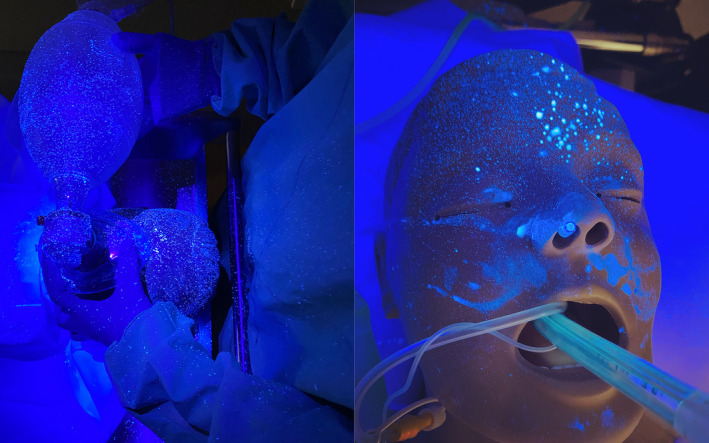The COVID‐19 pandemic has made it imperative to rapidly implement changes to typical medical practice in order to minimise spread of the SARS‐CoV‐2 virus. Many of these changes are non‐intuitive or differ significantly from normal practice. For this reason, we read with great appreciation the timely article by Fregene et al. 1, which describes translational simulation leading to increased preparedness at their institution. With the recognition that aerosol generating procedures are of particular importance to practice due to their high risk of virus transmission, we offer an additional tool for COVID‐19 airway simulation training that helped consolidate learning and motivate change to practice in hospitals across Vancouver.
Here we describe two ways to integrate UV fluorescent powder, as a visual virus surrogate, into scenarios requiring tracheal intubation. Of note, droplet transmission is considered to occur with respiratory droplets which are by definition, > 5 microns, whereas airborne transmission occurs with droplets which are < 5 microns 2. We use Glo GermTM (Marlatek Inc., Brockville, ON, Canada) as the UV fluorescent powder in these simulations which is 5 microns in size 3.
Model 1: aerosolised powder
Remove one of the manikin's lungs and thread a 6.0 mm I.D. tracheal tube filled with 1/8 tsp of Glo Germ into the bronchial lumen, then inflate the cuff. Connect an elbow attachment with a CO2 sampling port to the tracheal tube. Connect an Ambubag to the elbow attachment and a 3 ml syringe filled with 1/16 tsp of Glo Germ to the sampling port. During airway management, squeeze the Ambubag to send plumes of Glo Germ into the airway and surrounding area when there are breaches to optimal management (inadequate neuromuscular blockade, during attempts at bag‐valve‐mask ventilation, failure to inflate tracheal tube cuff adequately, etc.).
Model 2: mixed atomised particles and liquid
Mix Glo Germ into a 250 ml bag of saline to the desired level of UV luminescence. Thread a mucosal anatomising device with extension tubing from the nose through to the oesophagus of the manikin. Fill a 5‐ml syringe with Glo Germ liquid and attach it to the mucosal anatomising device. During airway management, when the practitioner changes from a simple mask to Ambubag, spray Glo Germ liquid out from the nostril.
In both models, mix minimal Glo Germ with airway lubricant or petroleum jelly to apply to the manikin lips, tongue, cheeks and the tracheal tube cuffs of any to be used in the scenario. The UV fluorescent powder dispersal apparatus of either model may be concealed from sight under a patient gown. Illuminate the scene and participants’ personal protective equipment (PPE) with black light at the end of the scenario, as well as before and after doffing PPE, in order to view Glo Germ dispersal.
Figure 1 shows Glo Germ dispersal after airway management breech using model 1 (left) and model 2 (right), illuminated with black light (please note the nasal mucosal anatomising device visible in model 2).
Figure 1.

Glo Germ™ dispersal after airway management breech using model 1 (left) and model 2 (right), illuminated with black light (please note the nasal mucosal anatomising device visible in model 2).
Before adopting either model it is essential to be clear on the educational objectives of the simulation scenario. The UV light reveal is impactful enough that it will weigh most strongly in participant learning, regardless of the teaching goals during debriefing. Whereas model 1 results in contamination of equipment within 1 m of the manikin, model 2 contaminates more widely. Both offer evidence of direct contamination from contact with the Glo Germ lubricant applied to various surfaces. Model 1 is more representative of aerosolised contamination due to Glo Germ's particle size of 5 microns, whereas the nasal mucosal anatomising device in model 2 creates a mix of 30–100 micron droplets 4. Model 2 introduces the potential for secondary dispersal and contamination with doffing, which is a major source of staff self‐contamination. Mindful extrapolation to clinical practice is required when using either model, given their inherent differences from true virus transmission.
When used appropriately and in line with educational objectives, UV fluorescent powder offers a powerful visual tool in simulation training to reinforce, guide and consolidate changes to airway management for suspected and confirmed COVID‐19 patients.
No competing interests declared.
References
- 1. Fregene TE, Nadarajah P, Buckley JF, Bigham S, Nangalia V. Use of in situ simulation to evaluate the operational readiness of a high‐consequence infectious disease intensive care unit. Anaesthesia 2020; 75: 733–8. [DOI] [PubMed] [Google Scholar]
- 2. Atkinson J, Chartier Y, Pessoa‐Silva CL, et al., editors. Natural ventilation for infection control in health‐care settings. Geneva: World Health Organization; 2009. Annex C, Respiratory droplets. www.ncbi.nlm.nih.gov/books/NBK143281/(accessed 30/03/2020). [PubMed] [Google Scholar]
- 3. Glo Germ . www.glogerm.com/history.html (accessed 30/03/2020).
- 4. Intranasal Mucosal Anatomization Device . https://mms.mckesson.com/product/844475/Teleflex-Medical-MAD300 (accessed 30/03/2020).


